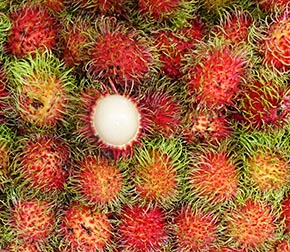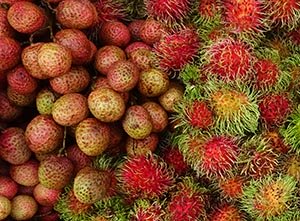Rambutan Nutrition facts
Rambutan is another delicious fruit in the lychee family (Sapindaceae) of tropical fruiting trees. Their outer rind is covered with soft, pliable, hairy spines and hence acquired the name "rambut" in Malay.
Botanically, this exotic fruit named scientifically as Nephelium lappaceum L.
Some of the common names are ramboostan, hairy lychee, litchi chevelu or ramboutan (French), Ngeāa (เงาะ- Thai), Chôm chôm (Vietnamese), etc.
 |
| Rambutan fruits. Note white-aril inside. |
Nephelium lappaceum is an evergreen tree about 10-12 m tall and grows well in humid, tropical climates. Round, ovoid fruits appear by June in clusters about 90 days after the fruit setting on the panicles.
Rambutan fruit measures about 1.8 in long and 1 to 1.5 in wide. The outer skin is 2 to 3 mm thick and covered with soft, long, kinky spines (hairs) that turn red or yellow when ripe. Inside, the juicy, rice-white, edible aril (flesh) is attached to a single, large seed as in litchi in clinging types. Freestone cultivars also exist and are preferred over clinging varieties.
The flavor and texture are almost similar to lychees but a bit more acidic. Seeds are inedible and poisonous.
Pulasan is closely related to and has a much more pleasant flavor than rambutan and lychee.
Health benefits of Rambutan
Fresh rambutan fruit carries 75 calories per 100 g of edible portion. It has no saturated fats or cholesterol but is composed of good amounts of dietary fiber, vitamins, and antioxidants.
In contrast to lychees, rambutans lack "Oligonol," a low molecular weight polyphenol. Nevertheless, they do contain alternative antioxidants such as vitamin C and polyphenols.
Rambutan carries about 30 mg of vitamin-C; 50% of daily recommended value. Studies suggest that the consumption of fruits rich in vitamin C helps the human body develop resistance to combat infectious agents and scavenge harmful, pro-inflammatory free radicals.
It carries good amounts of dietary fiber, 0.24 g per 100 g.
- Fresh fruits are very good sources of B-complex vitamins such as riboflavin, niacin, and folates. These vitamins are essential since they function by acting as co-factors to help the body metabolize carbohydrates, protein, and fats.
Rambutan also carries many minerals like calcium (10.6 mg), phosphorus (12.9 mg), and copper. Being a juicy tropical fruit, it holds good amounts of potassium, an important component of cells and body fluids that help control heart rate and blood pressure; thus, it offers protection against stroke and coronary heart diseases. Copper is required in the production of red blood cells.
| Principle | Nutrient Value |
|---|---|
| Energy | 75 kcal |
| Carbohydrates | 16.02 g |
| Protein | 0.46 g |
| Cholesterol | 0 mg |
| Dietary Fiber | 0.24 g |
| Vitamins | |
| Vitamin C | 30 mg |
| Minerals | |
| Calcium | 10.6 mg |
| Phosphorus | 31 mg |
Selection and storage
 |
| Rambutan and lychee fruits as displayed in a shop- Kuala Lumpur. |
Rambutan tree yields twice a year. Fresh fruits, therefore, start arriving in the markets by June and last till December. Buy fresh-looking berries. Roll fingers over the fruit to ascertain its soft, flexible spines (hairs) for freshness. Avoid those that appear dried, shriveled, and brittle hairs as they indicate old stock.
At home, place them in a cool place in a fruit bowl, occasionally moistened to keep them fresh. Eat them while fresh. They may stay fresh for up to 5 days at room temperature and for 10-12 days inside the refrigerator set at appropriate humidity.
Peeled/seeded fruits, however, perish early and should be consumed early. They can also be frozen or dried and canned for the purpose of exporting.
Preparation and serving methods
Rambutans can be used in the same way as lychee and longans. To prepare, just wash the fruit in cold water and mop dry using a clean towel. Make a superficial incision on the rind using a paring knife and twist to separate the upper half of the cup.
Alternatively, as natives of Malay do, just break the rind with your thumb and twist/untwist to pull off the shell. As in litchis, take care not to squeeze its flesh, or else, you may end up squirting and lose juice! Next, carefully peel away the tough outer skin along with the thin inner membrane to expose beautiful jelly-textured, translucent white flesh.
Eat peeled the whole berry in one go! Do not bite. To enjoy, gently suck its divinely sweet juice, rolling it between your tongue and palate, and then just spit out its seed (pit).
Here are some serving tips:
Fresh rambutan should be enjoyed all alone without any additions/seasonings.
Its sections can be a great addition to fruit salads and as garnish.
Rambutan juice/syrup can be a refreshing summer drink.
As in litchis, it also can be used in jellies, jams, sorbets, sauces, and syrups.
Safety profile
Rambutan fruit is well tolerated and allergic reactions are quite rare to occur. Pregnant women and children can safely eat seeded, sweet arils. Seeds contain saponin alkaloids and should be discarded.
People with diabetes may want to avoid eating too many of them because of their high sugar content. (Medical disclaimer)
You may also like to read ≻≻-
≺≺ Lanzone (langsat) fruit nutrition facts and health benefits.
≺≺ Lychee (litchi) nutrition facts and health benefits.
≺≺ Back to Fruits from Rambutan. Visit here for an impressive list of all varieties of fruits with complete illustrations of their nutrition facts and health benefits.
≺≺ Back to Home page.
Further References:
Food Value Per 100 g of Edible Portion. (opens new window)
Stanford School of Medicine Cancer information Page- Nutrition to Reduce Cancer Risk (Link opens in new window).